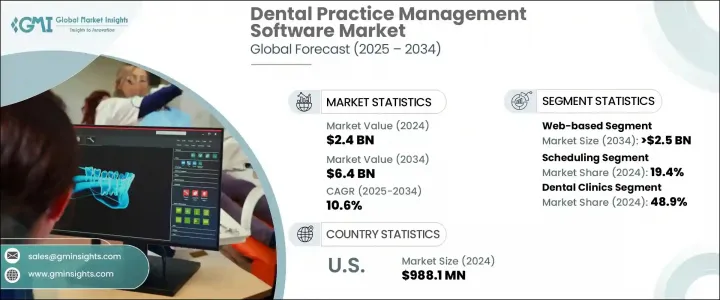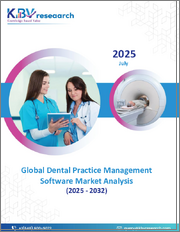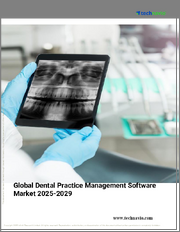
|
시장보고서
상품코드
1797887
치과 진료 관리 소프트웨어 시장 기회, 성장 촉진요인, 산업 동향 분석 및 예측(2025-2034년)Dental Practice Management Software Market Opportunity, Growth Drivers, Industry Trend Analysis, and Forecast 2025 - 2034 |
||||||
세계의 치과 진료 관리 소프트웨어 시장 규모는 2024년에는 24억 달러로 평가되었고, CAGR 10.6%를 나타내 2034년에는 64억 달러에 이를 것으로 전망됩니다.
시장의 성장을 지원하는 것은 치과 치료 건수 증가, 환자의 컴플라이언스 중시의 높아짐, 합리화된 오퍼레이션의 필요성입니다. 환자 수가 증가함에 따라 클리닉과 병원은 수동 스케줄링과 과거의 스프레드 시트에서 통합 디지털 솔루션으로 전환하고 있습니다. 첨단 플랫폼은 현재 의료 제산업체가 관리 업무와 임상 업무 워크플로를 보다 효율적으로 관리하는 데 도움을 줍니다. 또한 원격 치과 진료의 보급과 정부의 디지털 헬스케어 전략도 도입의 기폭제가 되고 있습니다.

치과 진료 관리 소프트웨어는 스케줄링, 청구, 보험 처리, 치료 계획, 이미지 관리, EHR 통합, 환자 참여 커뮤니케이션 등의 핵심 업무를 지원하는 데 필수적입니다. CareStack, Patterson Companies, Curve Dental, Henry Schein, Planet DDS와 같은 공급자는 이러한 기능을 통합하는 종합적인 시스템을 제공합니다. 이 플랫폼은 치과 진료소가 복잡한 워크 플로우(복수 사이트 스케줄링 및 청구 처리에서 실시간 업무 보고서까지)를 단일 통합 환경에서 처리하는 데 도움이 됩니다. 치과 진료소는 여러 독립 시스템을 다루지 않고 통합된 기능을 제공하는 솔루션에 대한 투자를 늘리고 있습니다.
| 시장 범위 | |
|---|---|
| 시작 연도 | 2024년 |
| 예측 연도 | 2025-2034년 |
| 시작 금액 | 24억 달러 |
| 예측 금액 | 64억 달러 |
| CAGR | 10.6% |
웹 기반 솔루션은 2024년 40.1%의 점유율을 획득했습니다. 이 부문은 클라우드 네이티브 아키텍처, 데이터베이스에 대한 중앙 집중식 액세스 및 확장 가능한 배포 모델을 선도합니다. 클라우드 기반 솔루션을 통해 여러 치과 클리닉과 그룹 클리닉이 소프트웨어를 설치하거나 업데이트할 필요 없이 인터넷에 연결할 수 있는 장치에서 환자 기록 및 업무 기록에 안전하게 액세스할 수 있습니다. 이 유연성은 원격 근무, 합병 및 클리닉 네트워크의 급속한 확장을 지원합니다.
예약 스케줄링 도구 분야는 2024년 19.4%에서 가장 높은 단일 기능 점유율을 차지했습니다. 수요가 증가하고 환자 흐름이 복잡해짐에 따라 클리닉에서는 무단 취소를 줄이고 임상의의 가동률을 최적화하며 예약 간격을 최소화하는 효율적인 스케줄링 시스템이 필요합니다. 자동 알림, 실시간 캘린더 동기화 및 과거 환자 트래픽을 기반으로 한 AI 주도 예측 스케줄링은 효율성과 환자 만족도를 보장하는 데 매우 중요해지고 있습니다.
유럽의 치과 진료 관리 소프트웨어 시장은 2024년 5억 7,250만 달러에 달했습니다. 이 지역의 성장의 원동력이 되는 것은 치과의 디지털 변혁에 대한 폭넓은 관심과 공중 보건의 디지털화 이니셔티브의 지원입니다. 클라우드 기반 플랫폼과 AI를 활용한 자동화가 저렴한 가격과 모듈식 기능 세트로 인기를 끌고 있습니다. 지역 벤더와 세계 기업 모두 치과 의사회 및 임상 네트워크와 협력하여 플랫폼의 보급을 확대하고 있습니다. 이러한 파트너십은 차세대 소프트웨어 기능에 대한 투자와 함께 이 지역의 탄탄한 기세를 이어가고 있습니다.
이 시장을 형성하는 중요한 공급자는 Datacon Dental Systems, CareStack, Epic Systems, Patrterson Companies, Curve Dental, Adroit Infosystems, Oryx Dental, DentiMax, Veradigm, Carestream Dental, NextGen Healthcare, Henry Schein, Planet DDS 등을 포함합니다. 선도적인 공급업체는 EHR, 이미지 프로세싱, 스케줄링 및 청구 모듈을 원활하게 통합하는 상호 운용 가능한 올인원 플랫폼에 투자함으로써 비계를 강화하고 있습니다. 진단 장비 제산업체와 원격 치과 의료 네트워크와의 전략적 파트너십으로 솔루션의 생태계가 확대되고 있습니다. 각 회사는 모바일 친화적인 인터페이스를 통해 편리함을 향상시키고 예약 예측 및 환자 유지를위한 예측 분석을위한 인공지능 기능을 통합합니다. 네트워크화된 진료를 지원하기 위해 제산업체는 지역 지원 센터를 배포하고 지역 데이터 프라이버시 및 규제 요구 사항을 준수하는 지역화된 버전을 제공합니다. 자동화된 청구 처리, 음성 문서화, 클라우드 기반 협업 도구 등 지속적인 제품 혁신은 제품 차별화와 지속적인 시장 도입을 촉진하는 데 도움이 됩니다.
목차
제1장 조사 방법과 범위
제2장 주요 요약
제3장 업계 인사이트
- 생태계 분석
- 공급자의 상황
- 각 단계에서의 부가가치
- 밸류체인에 영향을 주는 요인
- 업계에 미치는 영향요인
- 성장 촉진요인
- 구강질환의 이환율 증가
- 치과 진료소와 의사 수 증가
- 클라우드 기반 및 AI 대응 솔루션으로의 전환
- 통합 환자 관리 시스템 수요 증가
- 업계의 잠재적 위험 및 과제
- 소프트웨어 도입의 초기 비용이 높아
- 데이터 프라이버시와 사이버 보안에 대한 우려
- 시장 기회
- 신흥국의 치과 서비스 확대
- 분석 주도 환자 참여 도구 수요 증가
- 성장 촉진요인
- 성장 가능성 분석
- 규제 상황
- 향후 시장 동향
- 가격 분석
- 기술과 혁신의 상황
- Porter's Five Forces 분석
- PESTEL 분석
제4장 경쟁 구도
- 서론
- 기업의 시장 점유율 분석
- 기업 매트릭스 분석
- 주요 시장 기업의 경쟁 분석
- 경쟁 포지셔닝 매트릭스
- 주요 발전
- 합병과 인수
- 파트너십 및 협업
- 신제품 발매
- 확장 계획
제5장 시장 추계·예측 : 배포 모드별(2021-2034년)
- 주요 동향
- On-Premise
- 웹 기반
- 클라우드 기반
제6장 시장 추계·예측 : 용도별(2021-2034년)
- 주요 동향
- 스케줄
- 환자 커뮤니케이션
- 인보이스/청구
- 결제 처리
- 보험 관리
- 치과 차트 작성
- 기타 구성 요소
제7장 시장 추계·예측 : 최종 용도별(2021-2034년)
- 주요 동향
- 치과 진료소
- 병원
- 기타 용도
제8장 시장 추계·예측 : 지역별(2021-2034년)
- 주요 동향
- 북미
- 미국
- 캐나다
- 유럽
- 독일
- 영국
- 프랑스
- 스페인
- 이탈리아
- 네덜란드
- 아시아태평양
- 중국
- 일본
- 인도
- 호주
- 한국
- 라틴아메리카
- 브라질
- 멕시코
- 아르헨티나
- 중동 및 아프리카
- 남아프리카
- 사우디아라비아
- 아랍에미리트(UAE)
제9장 기업 프로파일
- Adroit Infosystems
- Care Stack
- Carestream Dental
- Curve Dental
- Datacon Dental Systems
- DentiMax
- Epic Systems
- Henry Schein
- NextGen Healthcare
- Oryx Dental
- Patterson Companies
- Plant DDS
- Veradigm
The Global Dental Practice Management Software Market was valued at USD 2.4 billion in 2024 and is estimated to grow at a CAGR of 10.6% to reach USD 6.4 billion by 2034. The market growth is underpinned by the rising volume of dental procedures, an increased emphasis on patient compliance, and the need for streamlined operations. As patient load expands, clinics and hospitals are moving away from manual scheduling and outdated spreadsheets toward integrated digital solutions. Advanced platforms now help providers manage both administrative and clinical workflows more efficiently. Rising adoption of tele-dentistry capabilities and government-backed digital healthcare strategies are also serving as key adoption catalysts.

Dental practice management software has become essential for supporting core tasks like scheduling, billing, insurance processing, treatment planning, imaging management, EHR integration, and patient engagement communications. Providers such as CareStack, Patterson Companies, Curve Dental, Henry Schein, and Planet DDS are offering comprehensive systems that consolidate these capabilities. These platforms help dental practices handle complex workflows-from multi-location scheduling and claims processing to real-time operational reporting-within a single unified environment. Clinics are increasingly investing in solutions that deliver unified functionality without handling multiple disconnected systems.
| Market Scope | |
|---|---|
| Start Year | 2024 |
| Forecast Year | 2025-2034 |
| Start Value | $2.4 Billion |
| Forecast Value | $6.4 Billion |
| CAGR | 10.6% |
Web-based solutions captured 40.1% share in 2024. This segment leads due to its cloud-native architecture, centralized database access, and scalable deployment model. It enables multi-office dental service organizations and group practices to access patient and business records securely from any internet-enabled device without requiring software installation or updates. This flexibility supports remote work, mergers, and rapid expansion of clinic networks.
The appointment scheduling tools segment accounted for the highest single functionality share at 19.4% in 2024. With growing demand and more complex patient flows, clinics need efficient scheduling systems to reduce no-shows, optimize clinician utilization, and minimize gaps between appointments. Automated reminders, real-time calendar syncing, and AI-driven predictive scheduling-based on historical patient traffic-are becoming pivotal in ensuring efficiency and patient satisfaction.
Europe Dental Practice Management Software Market reached USD 572.5 million in 2024. Growth in the region is being driven by widespread interest in digital dental transformation and supportive public health digitization initiatives. Cloud-based platforms and AI-enhanced automation are gaining traction for their affordability and modular feature sets. Regional vendors and global players alike are collaborating with dental associations and clinical networks to expand platform uptake. These partnerships, coupled with investments in next-generation software capabilities, continue to drive robust regional momentum.
Significant providers shaping this market include Datacon Dental Systems, CareStack, Epic Systems, Patterson Companies, Curve Dental, Adroit Infosystems, Oryx Dental, DentiMax, Veradigm, Carestream Dental, NextGen Healthcare, Henry Schein, and Planet DDS. Leading vendors are strengthening their foothold by investing in interoperable, all-in-one platforms that seamlessly integrate EHR, imaging, scheduling, and billing modules. Strategic partnerships with diagnostic equipment providers and tele-dentistry networks expand their solution ecosystems. Companies are enhancing usability through mobile-friendly interfaces and embedding artificial intelligence features for predictive analytics in appointment forecasting and patient retention. To support networked practices, providers are rolling out regional support centers and localized versions that comply with local data privacy and regulatory requirements. Continuous product innovation-such as automated claims processing, voice-enabled documentation, and cloud-based collaboration tools-helps differentiate offerings and drive sustained market adoption.
Table of Contents
Chapter 1 Methodology and Scope
- 1.1 Market scope and definitions
- 1.2 Research design
- 1.2.1 Research approach
- 1.2.2 Data collection methods
- 1.3 Data mining sources
- 1.3.1 Global
- 1.3.2 Regional/Country
- 1.4 Base estimates and calculations
- 1.4.1 Base year calculation
- 1.4.2 Key trends for market estimation
- 1.5 Primary research and validation
- 1.5.1 Primary sources
- 1.6 Forecast model
- 1.7 Research assumption and limitations
Chapter 2 Executive Summary
- 2.1 Industry 3600 synopsis
- 2.2 Key market trends
- 2.2.1 Regional trends
- 2.2.2 Deployment mode trends
- 2.2.3 Application trends
- 2.2.4 End use trends
- 2.3 CXO perspectives: Strategic imperatives
- 2.3.1 Key decision points for industry executives
- 2.3.2 Critical success factors for market players
- 2.4 Future outlook and strategic recommendations
Chapter 3 Industry Insights
- 3.1 Industry ecosystem analysis
- 3.1.1 Supplier landscape
- 3.1.2 Value addition at each stage
- 3.1.3 Factor affecting the value chain
- 3.2 Industry impact forces
- 3.2.1 Growth drivers
- 3.2.1.1 Increasing prevalence of oral health disorders
- 3.2.1.2 Rising number of dental clinics and practitioners
- 3.2.1.3 Shift toward cloud-based and AI-enabled solutions
- 3.2.1.4 Growing demand for integrated patient management systems
- 3.2.2 Industry pitfalls and challenges
- 3.2.2.1 High initial cost of software implementation
- 3.2.2.2 Data privacy and cybersecurity concerns
- 3.2.3 Market opportunities
- 3.2.3.1 Expansion of dental services in emerging economies
- 3.2.3.2 Rising demand for analytics-driven patient engagement tools
- 3.2.1 Growth drivers
- 3.3 Growth potential analysis
- 3.4 Regulatory landscape
- 3.5 Future market trends
- 3.6 Pricing analysis
- 3.7 Technology and innovation landscape
- 3.8 Porter's analysis
- 3.9 PESTEL analysis
Chapter 4 Competitive Landscape, 2024
- 4.1 Introduction
- 4.2 Company market share analysis
- 4.3 Company matrix analysis
- 4.4 Competitive analysis of major market players
- 4.5 Competitive positioning matrix
- 4.6 Key developments
- 4.6.1 Merger and acquisition
- 4.6.2 Partnership and collaboration
- 4.6.3 New product launches
- 4.6.4 Expansion plans
Chapter 5 Market Estimates and Forecast, By Deployment Mode, 2021 - 2034 ($ Mn)
- 5.1 Key trends
- 5.2 On-premises
- 5.3 Web-based
- 5.4 Cloud-based
Chapter 6 Market Estimates and Forecast, By Application, 2021 - 2034 ($ Mn)
- 6.1 Key trends
- 6.2 Scheduling
- 6.3 Patient communication
- 6.4 Invoice/billing
- 6.5 Payment processing
- 6.6 Insurance management
- 6.7 Dental charting
- 6.8 Other components
Chapter 7 Market Estimates and Forecast, By End Use, 2021 - 2034 ($ Mn)
- 7.1 Key trends
- 7.2 Dental clinics
- 7.3 Hospitals
- 7.4 Other end use
Chapter 8 Market Estimates and Forecast, By Region, 2021 - 2034 ($ Mn)
- 8.1 Key trends
- 8.2 North America
- 8.2.1 U.S.
- 8.2.2 Canada
- 8.3 Europe
- 8.3.1 Germany
- 8.3.2 UK
- 8.3.3 France
- 8.3.4 Spain
- 8.3.5 Italy
- 8.3.6 Netherlands
- 8.4 Asia Pacific
- 8.4.1 China
- 8.4.2 Japan
- 8.4.3 India
- 8.4.4 Australia
- 8.4.5 South Korea
- 8.5 Latin America
- 8.5.1 Brazil
- 8.5.2 Mexico
- 8.5.3 Argentina
- 8.6 Middle East and Africa
- 8.6.1 South Africa
- 8.6.2 Saudi Arabia
- 8.6.3 UAE
Chapter 9 Company Profiles
- 9.1 Adroit Infosystems
- 9.2 Care Stack
- 9.3 Carestream Dental
- 9.4 Curve Dental
- 9.5 Datacon Dental Systems
- 9.6 DentiMax
- 9.7 Epic Systems
- 9.8 Henry Schein
- 9.9 NextGen Healthcare
- 9.10 Oryx Dental
- 9.11 Patterson Companies
- 9.12 Plant DDS
- 9.13 Veradigm



















